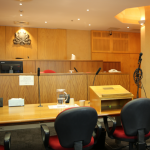Empowering Women Inmates: An Interview with WIPAN President Kat Armstrong

More women in Australia are being incarcerated than ever before. Australian Bureau of Statistics figures suggest that since 2005, the incarceration rate for women has risen by close to 40 percent, compared with 18 percent for men.
Women account for around 8 percent of the total Australian prison population. As of June 30 last year, there were 2,876 female inmates, an 11 percent increase on the year before.
Systemic disadvantage
However, the prison system often overlooks the gender-specific needs women have on the inside. Many female inmates have suffered family violence, have high levels of mental illness and substance misuse. And approximately 70 percent of women in prison are primary carers of children.
Most incarcerated women are from disadvantaged backgrounds – around 78 percent report having a history of sexual and/or physical abuse.
The vast majority of female inmates – around two-thirds – are sentenced for minor offences, serving less than six months in custody. Many serve lengthy periods on remand awaiting their trials.
On release, the situation faced by women is bleak.
Many find that their children have gone into foster care, and they’ve lost their home and property. However, there’s very little post-release support for women out there, which makes reintegrating all the more difficult.
The network
That’s where the Women in Prison Advocacy Network (WIPAN) comes in. Established in 2008, WIPAN is a grassroots organisation committed to advocating for the rights of women and female youth affected by the criminal justice system, and providing them with support.
WIPAN’s management committee is comprised of seven women, some of whom have had direct experience with the criminal justice system. Their aim is to reduce the recidivism rate of female inmates and to advocate for systemic change within the women’s prison system.
Since 2010, WIPAN has been running a volunteer-based mentoring program for women leaving prison. During its time in operation, they’ve mentored 406 women.
Between 2013 and 2016, 93 percent of participants in the program haven’t reoffended. This is despite 77 percent of them having served between five and seven prior custodial sentences.
The women’s advocate
Kat Armstrong is the president of WIPAN. She founded the organisation along with four others, after attending a Sisters Inside conference in 2007.
The long-term advocate has spent time on the inside. Coming from a disadvantaged background, Ms Armstrong turned to crime to support her drug dependency. She served three prison terms for ten different types of offences, including fraud.
In 2002, Ms Armstrong started studying a law degree via correspondence at the Southern Cross University, which she completed after her release. She’s currently finishing her Graduate Diploma in Law. It will allow her to submit her application to the NSW Supreme Court to practice law.
Sydney Criminal Lawyers® spoke with Kat Armstrong, president of WIPAN, about the plight of women in the prison system and the work her organisation is doing to help them back into the community.
What sort of gender-specific issues do incarcerated women and female youth face in the NSW prison system?
They face multiple complex issues. Almost 80 percent of women that go to prison have been the victim of either sexual assault, domestic violence or verbal abuse of some sort – either as a child or a teenager or as an adult.
So before they become criminalised, they have been a victim themselves.
What happens nine out of ten times is they then start to self-medicate – either with prescription medication and/or illegal drugs – and then to support that habit, they then start to commit crime. Because they don’t have the family or supports in place to deal with the traumas that have occurred to them.
It’s the use of the drugs that then causes them to become criminalised and commit crime to get the money to sustain the drug addiction.
Some of the stories are the most horrific you could possibly imagine. And how they’ve actually survived and got to where they are today is just truly inspirational.
So that’s the biggest issue, given that they were a victim before they committed crime themselves and got no assistance.
Then 70 percent of women are mothers or the primary caregivers. When they get sent to prison, they then lose their home, whether it’s public housing or private. And a lot of the time, they’re estranged from their family because of their behaviour, so they then lose their children.
The other issues are, 82 percent of women who have been in prison have been diagnosed at some stage with a form of depression, bipolar or some sort of mental health condition. And a lot of the time have been misdiagnosed by doctors in prison.
As a form of control, the majority of women in gaol – almost 80 percent at some time throughout their gaol sentence – are put on antipsychotic medication. Because it zombies them out, they’re quite and they’re controllable. It just makes it easier for the system as a whole.
And for women leaving after a stint in gaol, what’s it like for them returning to life on the outside?
Unless you have extremely good family support and extremely good support services – such as WIPAN – in place prior to your release, you’re set up to fail.
That’s why in NSW we have a 49.7 percent recidivism rate – for any woman who goes to prison, will go back to prison within one to two years. So half do.
Since 2010, WIPAN’s been delivering an evidence-based mentoring program for women leaving prison. Can you tell me about how the program works? And how successful it’s been?
It’s a client-centred approach. Many agencies actually use that. But we are unique in the fact that, when we say client-centred approach, we have women with the lived experience of prison working in the organisation, on the board of the organisation, and mentoring women coming out of prison.
Not all mentors are women with lived experiences of prison. But they’ve had some other life experience. So maybe they were a prostitute once, but were lucky and never went to gaol. Or they were a drug addict that got clean and never got into trouble with the law. Or they were a victim of domestic violence and left their partner and went onto succeed.
So we have a diverse team. Currently, we have 66 mentors. And we’re at full capacity mentoring 66 women, when we’re only funded to mentor 45 to 50 women per year.
The reason we’ve had such success is because the woman that we mentor, it’s about them first and foremost. It’s not about telling them what we think they should do, and how they should do it. It’s about giving them the tools and finding the solutions for them to become empowered to implement those tools and solutions themselves.
So while we guide them and provide pathways, it’s the woman herself who has to be fully engaged and motivated and want to change – that makes the difference.
WIPAN has been so successful because the mentors are there in a voluntary capacity, standing beside a woman, when she’s never had any clean friend stand beside her most of her life.
They believe in her, when she’s never believed in herself. And they open socially inclusive networks with other clean, straight, law-abiding members of the community. And they guide them and motivate them, just by being there.
The clients have never had anyone guide them with no judgement and believe in them. And provide them with real actual pathways into education and employment. It makes the difference.
The reason women have succeeded in our program is due to the networks WIPAN has made with educational and employment providers that bypass the criminal record checks.
The average education level for women that go to gaol is between year seven and year nine. So to get into a tertiary course that allows you to finish your HSC and go on to university, is the most empowering thing.
That’s what changed my life when I got out.
I was mentored by two amazing people. They got me out of a boarding house that was full of people using drugs and committing crime.
When I was released, I was placed in a boarding house in the middle of Blacktown. I had been clean the entire duration of my sentence. I’d started a law degree. I had the best intentions in the world. But when I got out and had nowhere to live and half a social security cheque to live on for two weeks and a boarding house full of drug addicts and I’m a recovering heroin addict that was the reason I went to gaol – what hope did I have?
It was only that I remembered when I was in gaol, picking up a newspaper from an organisation called Justice Action.
I rang them up in tears and said, “Look, I just want to go back to gaol. I think I’m going to relapse. I’ve never felt so isolated and depressed in all my life. At least, I had women beside me in gaol, who were my good friends. Out here in the community, I’m surrounded by drug-taking people and people committing crime. And I’ve just locked myself away in this cockroach-infested boarding house and I know I cannot sustain this.”
And they said, “Come in straightaway.”
I got straight on the train and went there. Within two weeks, I was in share house accommodation, with straight, clean working people.
I was given a voluntary position at Justice Action to help with their campaigns. Because they said, “You have so much knowledge of the women’s criminal system. You’ve done ten years in gaol. You could help in so many of our campaigns. Would you be willing to do that?”
So it gave me a purpose. It gave me something positive to do: to give back to other women.
Then I was introduced to a professor at UNSW. I was 36 at this time. And for the first time in my life I was invited into a stranger’s home, with her children and her aged mother. She trusted me – knowing who I was – but she saw something. I spent Christmas day in her home. And it was the most inclusive family environment I had remembered for the whole of my life.
She helped me find a job. A short-term job, but it was at least something to get on a resume. Then I got another job and I was at that job for the next six years. I couldn’t wait to get up in the morning and go to work.
I had finally found myself and I could be a law-abiding, contributing member of the community. I was still regularly visiting the gaols the whole time I was out for those eight years. So I kept close to the prisoner community.
That was when I decided there should’ve been an agency for me, when I got out, that could mentor me like I was mentored. And who would help me to change my life.
That was why I then lobbied influential women. Because I knew as an ex-criminal the government wouldn’t give me funding. I knew I needed influential women to set up a board and to speak beside me. And the very first government minister I went to – which was Verity Firth in 2009 – she gave us $100,000 to start WIPAN.
What sort of rehabilitation or educational programs are on offer for women within the NSW prison system?
Very little. For first time white-collar criminals – say a bank teller who’s embezzled money – because she’s already got a degree, worked and got family support, she will get a credible job in gaol. She’ll be the one who will get that position – that will give her skills that she’s already got.
But the majority of women – that are going in and out – have never worked and haven’t gone past year nine.
Only 2 percent of the women’s prison population get to go on programs such as work release or study leave.
I was a serial recidivist. I did three gaol sentences that added up to just over ten years. It took me two years of that last four and a half year sentence to get approval to do a law degree. And it wasn’t because of the custodial officers. It was because of an education officer, who was at the gaol at the time. She knew that I was capable and had persisted for two years.
So they finally reached out to Southern Cross University and said, “Will you take on this woman to do this course externally. She’s got no internet. She’s got no law library. So you’ll just have to give her the books and see how she goes.”
And they gave me the opportunity.
Silverwater Prison holds 275 women, not one woman out of them is doing full-time education. Many are doing part-time, but that consists of Certificate I or II of basic computer, basic numeracy or literacy, or art and pottery. That’s what’s available at Silverwater for part-time education.
The reason women are not doing full-time education is because they rely on their gaol wage to survive. They have to buy all their toiletries and if you do full-time education you get paid between $28 and $36. If you work in a Corrective Services industry, you can earn up to $65 dollars a week.
So there’s no incentive for women to do full-time education, where they could be empowered.
That’s why there should be computers in cells. You’re locked in at twenty past three in the afternoon. You don’t get out until eight o’clock the next morning. And some days you’re locked in for two or three days in a row, because of staff shortages.
A computer in a cell would mean online education and counselling. It’s already happening in gaols in other parts of Australia, with security fully in place and not being abused.
You served multiple sentences in gaol adding up to 10 years. What sort of injustices did you see?
I saw many injustices. But I’ll point out one injustice that I was a witness to and a part of.
A woman was getting drugs in. So our wing that this woman was in, were all lined up and told to strip. We had men and female officers in front of us and behind us. And they were videotaping us, while we’re being stripped naked and searched. And officers were getting down on the floor and looking up at our vaginas.
Now, I can assure you. This is in no policy or procedure of any of Corrective Services regulation – that they’re allowed to do that.
Nothing was found on one single person. Not even the woman who had been getting the drugs in.
We were then each taken in separately and a form was put in front of us. And we were told to sign it – that we would not disclose either during our sentence or after our sentence what had just occurred.
So while it wasn’t written on the paper it was verbally and very directly said, “If you don’t sign this consent form – that you were just strip searched as per regulation – classification will be very difficult for the rest of your sentence.”
Every one of us signed that form, because we had no choice.
I’m a victim of sexual assault. When you have men and women doing that to you and it’s in front of nine other women – I felt raped. I felt violated. It was worse than the sexual assault that I suffered as a child. Because as I child, I didn’t actually understand what was being done to me. As an adult, I knew exactly what they were doing was wrong.
So that’s just one of many, many things.
And what is WIPAN’s main focus at present?
Our main focus is to try and get more funding. There’s currently almost a thousand women sitting in prison in NSW. When I was released in 2003, there was about 580. The rate is just increasing like you wouldn’t believe.
The employment and education opportunities upon release equate to absolutely nothing to the majority of women in prison.
When we get phone calls and letters – which we get every week – saying my rights have just been violated and this just happen to me. We then advocate on their behalf.
So we do advocacy and we do mentoring. We want more money to mentor more women, because we know it works.
And we want to raise more public awareness and education, so that people know the majority of these women are not evil women that need to be locked away from society. They’ve had the most dysfunctional and deprived lives.
And lastly, what’s the message that you most want to get out there?
Whether we like it or not, these women – bar two, because there’s only two in the whole of NSW that are sentenced to life – are coming back to our community.
Do we want them supported, rehabilitated and educated – contributing members of our community? Or do we continue to do nothing and let our community continue to be crime-riddled? And these women continue to use drugs and commit crime and keep going back into gaol?
It costs $200 a day for them to not get educated, employed or rehabilitated in gaol. Or it costs $14.54 for WIPAN to actually change their lives, so they’re contributing, law-abiding citizens of our community.
Kat thank you very much for speaking with us today. And best of luck with your advocacy work going into the future.
No worries. And thank you.







